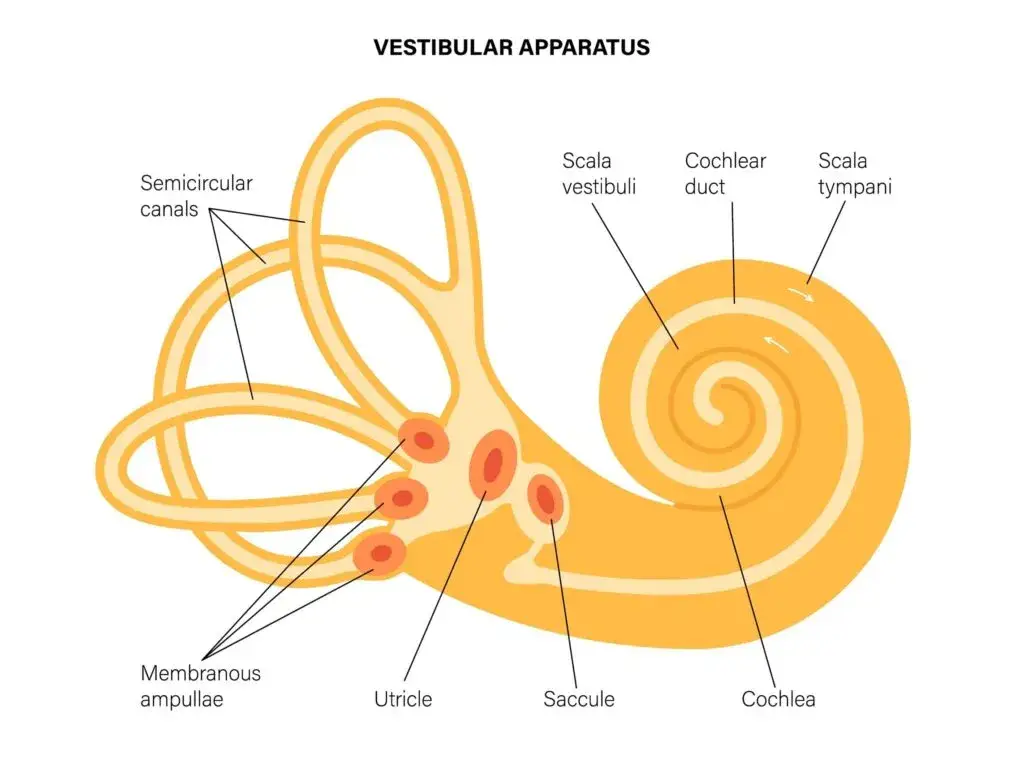
Can Migraine Cause Dizziness? Introduction: Why Your “Spinning” Might Be a Migraine—And What You Can Do About It
Can Migraine Cause Dizziness? If you’ve ever felt the room tilt, sway, or spin during a headache—or even on days without pain—you’re not alone. Dizziness and vertigo are among the most confusing and disruptive symptoms people in Sarasota, Bradenton, and Lakewood Ranch bring to our clinic. Many assume the inner ear is always to blame. But here’s the surprising truth: yes, migraine can absolutely cause dizziness, and there’s a specific subtype called vestibular migraine that places dizziness, imbalance, and motion sensitivity center stage.
The encouraging news? When we address the root drivers—especially subtle problems in the upper neck that irritate the brainstem and vestibular system—people often see life-changing relief. In this comprehensive guide, we’ll unpack how migraine works, how vestibular migraine and vertigo differ, why the upper cervical spine plays a pivotal role, and how gentle, precise care at Lavender Family Chiropractic can help you get your life back.
Migraine 101: More Than “Just a Headache”
Migraine is a complex neurological condition characterized by episodes of altered brain sensitivity, changes in blood vessel tone, and heightened activity in pain-processing networks. Yes, head pain is common—but migraines also bring a constellation of non-headache symptoms that can be just as disabling: nausea, light and sound sensitivity, eye strain, brain fog, neck stiffness, facial or jaw pain, fatigue, and yes—dizziness. Some people experience aura (visual zigzags, blind spots, tingling), while others never do.
Triggers range from stress, lack of sleep, and weather swings to hormones, certain foods, screen time, and musculoskeletal tension. The pattern is personal, but the underlying theme is a nervous system that’s primed—on a hair-trigger—toward overreaction.
The Trigeminocervical Connection: Where Headache and Neck Meet
One of the most important hubs in migraine is the trigeminocervical nucleus, a relay station in the brainstem where sensory input from the face (trigeminal nerve) and the upper neck (C1–C3) converge. When the upper cervical spine (especially at the atlas, C1, and axis, C2) is misaligned or restricted, it can bombard this hub with noxious “noise.” That irritation can amplify the pain pathways tied to migraine and sensitize networks that regulate balance, eye-head coordination, and even blood flow to the inner ear. In other words, neck problems don’t just coexist with migraine— they can drive it.
Dizziness vs. Vertigo vs. Imbalance—What’s the Difference?
- Dizziness is a general sense of lightheadedness, wooziness, or “off” feeling.
- Vertigo is the illusion of movement—most commonly spinning—of yourself or your environment.
- Imbalance is a feeling of unsteadiness or veering when walking, like your body can’t calibrate where “center” is.
All three can appear in migraine, but vertigo and imbalance are especially prominent in vestibular migraine.
What Is Vestibular Migraine?
Vestibular migraine is a migraine variant where episodes of vertigo, motion sensitivity, imbalance, or spatial disorientation are dominant features. Attacks can last minutes to hours (sometimes days), and may or may not include head pain.
Common Features of Vestibular Migraine
- Strong motion sensitivity (cars, boats, grocery store aisles)
- Visual motion triggers (scrolling phones, busy patterns, fluorescent lights)
- Ear fullness or pressure, sometimes mild tinnitus
- Neck tightness and a “heavy head” feeling
- Nausea without obvious GI illness
Because vestibular migraine overlaps symptoms with inner ear disorders like BPPV (loose “ear crystals”), Meniere’s disease, and persistent postural-perceptual dizziness (PPPD), getting a clear picture requires a careful history. The neck’s role is frequently overlooked, even though upper cervical irritation can set the stage for recurring attacks.
How Migraine Produces Dizziness and Vertigo
Migraine disrupts the balance networks that integrate input from the inner ear (vestibular), the eyes (visual), and your body-sense (proprioception)—especially the deep muscles and joints in the neck. When that calibration is off, your brain guesses wrong about where you are in space, and the world can feel like it’s tilting, bobbing, or shimmering.
At the same time, migraine-related blood flow changes, brainstem sensitivity, and autonomic imbalance (fight-or-flight vs. rest-and-digest) can add nausea, sweating, and a sense of doom. If the upper neck is misaligned, it adds a steady stream of “error signals” into the vestibular mix, making attacks more frequent and recovery slower.
Vestibular Migraine vs. BPPV (Ear Crystals): Key Clues
- BPPV attacks are brief (seconds to a minute), triggered by specific head positions, and often respond quickly to repositioning maneuvers like Epley.
- Vestibular migraine episodes can last longer, be triggered by visual motion, hormones, sleep changes, weather, or neck strain, and often include migraine features (photophobia, phonophobia, brain fog).
- Many people have both—BPPV history with a migraine brain. When the upper neck is stable and calm, BPPV episodes may be less frequent and less disabling.
Common Triggers in Sarasota & Manatee
Our coastal environment is gorgeous—and dynamic. Patients frequently report flares with storm fronts and barometric swings, long commutes, screen time, gym strain, and dehydration (particularly in the heat). Hormonal shifts, skipped meals, red wine, aged cheeses, and high-sugar snacks show up often. Add in an old whiplash, a forward-head posture desk setup, or years of subtle jaw clenching, and the upper neck can become a compounding trigger.
The Upper Cervical Spine: Why C1/C2 Matter So Much
The atlas (C1) and axis (C2) cradle the brainstem and act like a precision gimbal for your head. Hundreds of tiny mechanoreceptors in this region feed the brain constant data about position and movement. When C1/C2 shift out of ideal alignment—even slightly—the resulting irritation can:
- Sensitize the trigeminocervical nucleus (fueling head and face pain)
- Disturb eye-head reflexes (blurry vision, motion intolerance)
- Alter autonomic balance (nausea, cold hands, anxiety-like surges)
- Tighten suboccipital muscles (tension headaches, jaw strain)
Correcting those vectors gently and precisely can quiet the “noise,” letting the brain recalibrate balance and reduce migraine frequency, severity, and duration.
Upper Cervical Chiropractic: Gentle, Precise, and Focused on Root Cause
Unlike general “full-spine” approaches, upper cervical chiropractic zeroes in on the top of the neck with customized corrections—not popping, twisting, or cracking. At Lavender Family Chiropractic in Sarasota, we use 3D CBCT imaging to visualize the atlas and axis in detail, along with Tytron paraspinal infrared thermography (a functional nervous system scan) to measure stress patterns around the brainstem. We combine these findings with precise exam procedures to craft a personalized plan that restores alignment, stabilizes the correction, and supports long-term healing.
Our Clinical Process at Lavender Family Chiropractic
1) Complimentary Consultation
We listen—deeply. When did dizziness begin? What makes it worse? Any head or neck injuries? What do your “migraine days” look like?
2) 3D CBCT & Functional Scans
If your case is a good fit, we take CBCT to map your unique anatomy and measure misalignment vectors. With Tytron scans, we evaluate nerve patterning and stress.
3) Precision Upper Cervical Correction
Using an Advanced Knee–Chest approach, we deliver a gentle, highly specific adjustment tailored to your imaging and exam—no twisting or cracking.
4) Rest & Recheck
You’ll rest in a zero-gravity chair as your nervous system integrates the correction. We re-scan to confirm improvement.
5) Stabilization Plan
We space visits strategically, focusing on holding the correction rather than chasing symptoms. Home strategies (sleep, hydration, workstation tweaks, gentle mobility) support lasting stability.
6) Re-evaluation
We track progress across dizziness scales, migraine days, triggers tolerated, and quality-of-life metrics. Many report calmer motion sensitivity, steadier gait, and fewer attacks.
Why People with Vestibular Migraine Choose Us
- Imaging-Guided Precision: 3D CBCT means no guesswork.
- Functional Nervous System Scans: Tytron helps us measure change—not just hope for it.
- Gentle, No-Twist Approach: Ideal for sensitive migraine brains and necks.
- Team-Based Care: Dr. Rusty Lavender, Dr. Jacob Temple, and Dr. Will Guzinski collaborate on challenging cases.
- Local Leaders: We serve Sarasota, Bradenton, Lakewood Ranch, Parrish, Ellenton, Venice, Osprey, Punta Gorda, St. Petersburg, Siesta Key, Longboat Key, Lido Key, and Myakka City.
- Trusted Community: 120+ five-star reviews reflect outcomes and kindness.
Lifestyle Wins That Support Recovery
- Hydration & Minerals: Even mild dehydration can provoke dizziness. Aim for consistent water and consider electrolyte support if you sweat heavily.
- Sleep Regularity: A consistent bedtime/wake time calms a migraine-prone brain.
- Screen Savvy: Use blue-light filters, reduce screen brightness, and schedule breaks (the 20–20–20 rule).
- Neck-Sparing Workstation: Keep screens at eye level, shoulders relaxed, and feet supported.
- Gentle Mobility: Chin tucks, mid-back extension over a towel roll, and nasal breathing can be calming.
- Trigger Mapping: Track weather, foods, and cycles—but remember, triggers pile. As your neck stabilizes, many triggers become less potent.
When to Seek Immediate Medical Care
Red flags include sudden “worst-ever” headache, new neurological deficits (weakness, slurred speech, facial droop), double vision, chest pain, or a dramatic change in your usual pattern. Upper cervical care is a conservative, non-drug approach that complements—not replaces—medical evaluation. We collaborate with your healthcare team when needed.
A Composite Story We See Often
A Lakewood Ranch patient in her 40s arrives with weekly spinning episodes, nausea, and grocery-store aisle panic. She’s had “normal” ear tests and multiple medications with partial relief. Her history reveals a teenage concussion, a minor car bump years ago, and daily laptop work with a tucked chin. CBCT shows a right-sided atlas misalignment; Tytron scans reveal asymmetry at the brainstem level. We correct her upper cervical alignment, coach workstation changes, and space visits to help her hold the correction.
Over two months, her motion sensitivity fades, shopping becomes normal again, and “migraine days” drop from eight to two per month. Not every case is identical, but the pattern is common: stabilize the top of the neck, quiet the brainstem, and the balance system re-learns calm.
How Upper Cervical Care May Help Reduce Migraine Dizziness
- Less Brainstem Irritation: Quieter trigeminocervical input = fewer “false alarms.”
- Clearer Proprioceptive Signals: Better head–neck alignment improves spatial mapping.
- Autonomic Rebalance: People often report warmer hands, better digestion, and calmer sleep as the nervous system shifts out of high alert.
- Muscle De-Guarding: Suboccipital and jaw tension often melt as alignment normalizes.
What to Expect in the First 4–8 Weeks
Many notice early changes in neck lightness, motion tolerance, or sleep. Others see gradual shifts: shorter attacks, fewer “bad days,” or greater capacity to handle triggers like weather or screens. Our focus is holding the correction; as stability improves, we adjust less often—not more.
Top 15 FAQs About Migraine, Vestibular Migraine, and Dizziness
1) Can migraine really cause dizziness without a headache?
Yes. Vestibular migraine can present primarily as vertigo, motion sensitivity, or imbalance with little or no head pain. Other migraine features—light sensitivity, nausea, brain fog—often appear in the background.
2) How do I know if it’s vestibular migraine or BPPV (ear crystals)?
BPPV is usually brief and position-specific (seconds). Vestibular migraine can last longer, be triggered by visual motion, sleep/hormone shifts, or weather, and may include migraine symptoms. Some people have both. We screen your history carefully and collaborate with medical providers when needed.
3) Why does my neck feel tight with my migraines?
Upper cervical misalignment can cause suboccipital muscle guarding and send noisy signals into the trigeminocervical nucleus, amplifying migraine circuits. Correcting alignment often eases neck tightness and headache frequency together.
4) How does upper cervical chiropractic differ from regular chiropractic?
Upper cervical care is laser-focused on precise correction of C1/C2 using imaging and measurable functional scans. We use gentle, specific adjustments—no popping or twisting—designed to restore alignment and help you hold it.
5) Is upper cervical care safe for people with vestibular disorders?
Our method is gentle and tailored, making it a strong fit for sensitive systems. We avoid rapid twisting and use measured forces that respect your anatomy and tolerance.
6) Will I need adjustments forever?
Our goal is stability, not dependency. As your correction holds, we decrease visit frequency. Many patients transition to occasional check-ins, particularly during life stress or travel.
7) Can upper cervical care help if medications only partially work?
Yes, many patients who rely on medications for symptom control see additional improvements when we reduce the underlying neck-driven irritation. We are complementary to medical care, not a replacement.
8) Do you take insurance?
Our office is out of network with insurance. Many of our patients receive a superbill to submit to their insurance for reimbursement based on their coverage. We offer many different payment options as well as finance options.
9) What imaging do you use—and why?
We use 3D CBCT to visualize atlas/axis anatomy and misalignment vectors in detail. That clarity enables corrections tailored to your structure. We pair that with Tytron functional scans to track nervous system change over time.
10) What if storms or barometric pressure spark my dizziness?
Barometric shifts can tip a sensitized system into symptoms. By calming brainstem irritation and improving neck input, many patients become more resilient to weather swings. We’ll also coach hydration, sleep, and pacing strategies during fronts.
11) Can jaw/TMJ issues be part of this?
Absolutely. Jaw clenching and mal-tracking can increase trigeminal input, compounding head and neck tension. As upper cervical alignment normalizes, jaw mechanics often improve. We also coordinate with dental or PT providers when appropriate.
12) How long before I notice changes?
Some feel differences after the first correction (lighter head, calmer stomach, steadier walking). Others notice a steady trend over 4–8 weeks: fewer “bad days,” shorter episodes, and better tolerance for motion and screens.
13) Will you twist my neck?
No. Our Advanced Knee–Chest upper cervical corrections are gentle and precise—no popping, twisting, or cracking.
14) Do you work with kids or teens who get dizzy with screens or sports?
Yes. We frequently see students and athletes with concussion histories, motion sensitivity, and “migraine brain.” Our gentle approach and clear communication help younger patients feel safe and supported.
15) How do I get started?
Call us for a complimentary consultation. If your case is a fit, we’ll schedule your CBCT and functional scans, complete a detailed exam, and create a plan that prioritizes holding your correction for lasting results.
Who We Serve (And How to Find Us)
Lavender Family Chiropractic proudly serves Sarasota, Bradenton, Lakewood Ranch, Parrish, Ellenton, Venice, Osprey, Punta Gorda, St. Petersburg, Siesta Key, Longboat Key, Lido Key, and Myakka City. If you’re searching for “chiropractor Sarasota Florida,” “chiropractor near me,” “upper cervical chiropractor near me,” “Vertigo doctor near me,” or “Migraine doctor near me,” we’d be honored to be your first call. Our address is 5899 Whitfield Ave Ste 107, Sarasota, FL 34243. Website: www.chiropractorsarasotaflorida.com. Phone: (941) 243-3729. Instagram: @lavenderfamilysrq. TikTok: @drrustylavender.
Why Local Patients Choose Lavender Family Chiropractic
- Expertise in Complex Cases: Migraines with dizziness are our wheelhouse; we know how to listen and how to measure change.
- Data-Driven Care: 3D CBCT + Tytron scans help us map the path forward and verify progress.
- Three-Doctor Team: Dr. Rusty Lavender, Dr. Jacob Temple, and Dr. Will Guzinski collaborate to think through every angle.
- Gentle Matters: A sensitive brain deserves a precise, calm correction approach.
- Reputation for Results: 120+ five-star reviews reflect both outcomes and a caring experience.
Your Next Step: Move From Managing Symptoms to Restoring Stability
Living with dizziness or vertigo can make life feel small. Plans get canceled. Stores feel overwhelming. The fear of the “spin” becomes its own stressor. You deserve care that looks deeper than symptom suppression—care that respects your anatomy, your story, and your goals. If your dizziness has a migraine pattern—or if you’ve been told “everything is normal” yet you still feel unsteady—upper cervical misalignment may be the missing piece. Calming the brainstem by correcting C1/C2 alignment is a powerful way to quiet the noise and help your nervous system re-learn ease.
Ready to Feel Steadier? We’re Here for You
Lavender Family Chiropractic in Sarasota Florida offers complimentary consultations to learn more about you. Click the link below!
https://intake.chirohd.com/new-patient-scheduling/724/lavender-family-chiropractic
Visit our Website!
To learn more about us go to http://www.chiropractorsarasotaflorida.com
We also service Bradenton, Parrish, Ellenton, Ruskin, Venice, Tampa, St. Pete, Osprey, Longboat, Lakewood Ranch, Myakka City.
If you are not local, visit www.uccnearme.com to find a doctor in your area.
If you’re in Sarasota, Bradenton, Lakewood Ranch, or the surrounding communities, schedule your complimentary consultation at Lavender Family Chiropractic today. Let’s talk through your history, review your goals, and see if precise upper cervical chiropractic care is the right path for you.
Visit www.chiropractorsarasotaflorida.com or call





